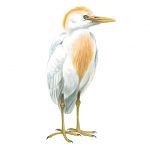As the Autumn migration started to ramp up in July, the birds were treated to a real mix of weather. July and August’s temperatures were well above average yet again. Successive heat waves were interspersed with cooler periods as Atlantic weather systems swung in from the west, although rainfall in August was notably below average. In contrast, September turned increasingly autumnal, with temperatures dropping below average as the month progressed and there was plenty of rainfall.
Wildfowl and the like
The build in wildfowl numbers witnessed in late-June continued into July. This was thanks to the prolific growth of Lesser Pondweed, Potamogeton pusillus, for the fourth summer in a row but dropped off markedly in the late summer.
On 1st July a new record of 225 Gadwall was logged along with 150 Mallard, a notable count for the latter these days, all feasting on the pondweed. Coot peaked at a very respectable 300 mid-month, comparable to 2024’s levels but this year’s build-up was earlier in the summer.
Other early peak wildfowl counts included 43 Shoveler and 24 Teal on 23rd August, both record counts for these species for the month of August, before numbers of both dropped off. The final tally on this year’s breeding Tufted Ducks was 16 broods with 40-50 young successfully raised.
Single Pochards put in the occasional appearance throughout the period as did Mandarin Duck, with three males of the latter sighted on 1st September. A non-native White-cheeked Pintail (also known as a Bahama Pintail) was observed on 19th July and remained present at the Reserve until at least 6th August. A native of Caribbean and South America, this individual was no doubt a wandering escapee enjoying its freedom from an unknown wildfowl collection. Pictured below credited to Christoph Moning.
christoph_moning – https://www.inaturalist.org/photos/94136093
As in previous years there was the usual late summer build-up of roosting geese, as those who live in earshot of the Pond can attest, with numbers peaking on 23rd August when 231 Canada Geese, and 208 Greylag Geese were logged leaving the Pond at dawn. They were accompanied by the single Pink-footed Goose which returned for its fifth year in a row to roost at the Reserve, being first sighted on 28th July and last seen on 1st September. Little Grebes were noted on September 6th and 18th (two).
Migrant waders were limited to a flyover Greenshank on 18th July, a Green Sandpiper on 28th July and two Common Sandpipers on 23rd August. Notable Gulls and Terns included a 3rd calendar year Yellow-legged Gull present on three dates between 16th-22nd July, a juvenile Mediterranean Gull between 3rd-15th September, mostly seen off the Chestnut Grove jetty and a late Black Tern which graced the Pond on 17th September. Common Terns peaked at six on 9th August and the first Common Gull of Autumn was logged on 30th August.
A Cattle Egret image above credited to RSPB www.rspb.org.uk/birds-and-wildlife/wildlife-guides/bird-a-z/
present early in the morning on 29th August (leaving west at 09:30), represented the Reserve’s second record of the year, while Great White Egrets were sighted on 14th August (a flyover heading west) and singles present on 20th, 22nd and 25th September.
Passerine Migrants
Notable passerine migrants included juvenile Dartford Warblers at the Dry Heath on 27th July and 13th September, single Spotted Flycatchers on five dates between 11th August and 2nd September, and a Pied Flycatcher on 28th August at the MoD common. Willow Warblers were recorded on five dates, with three sighted on 11th and 15th August. Peak counts of commoner warblers and chats included: Whitethroats (26 on 28th July); Blackcap (15 on 14th August); Common Chiffchaff (30 on 17th August); and Stonechat (9 on 28th August).
Hirundines
Hirundines were more plentiful than usual this September and peak counts included 250 House Martins feeding over the Pond in inclement weather on 10th September, 220 Sand Martins (image left) leaving a reedbed roost on 12th September and 100 Barn Swallows on 22nd September. The last Common Swift of the year was logged on 4th September, and other notables included a Hobby on 29th August and a flyover Raven heading south on 3rd September.
Peak roost counts during the period included 11 Little Egret (12th July), 24 Cormorant (16th September) and 250 Jackdaw (14th September). Good birding!
William Legge
Contributing Observers: Arun Bose, John Clark, Steve Collins, Matthew Daw, E Gladwin, Nikki Golder, Katie MacDonald, Spike Millington, Stephen Perry, Lynn Randolph, Noel Silver, Sarah Slingo, Graham Stephenson.


